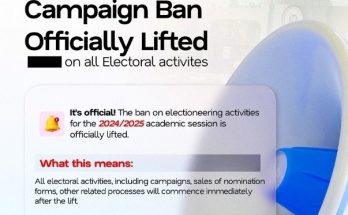By: Olayemi Islamiyyah
Imagine logging into your school portal after your first or second year at the university, full of excitement as a freshman or with the eagerness of a final-year student ready to face the real world, only to find that your tuition fees have skyrocketed to a level you wished was only a bad dream. For many, this has become a harsh reality, pushing students to the brink of dropping out and shutting the door to higher education for countless others.
Tertiary education in Nigeria has increasingly become a privilege for the wealthy. Even federally owned institutions, once relatively affordable, have joined the trend of abrupt fee hikes, leaving students under immense financial pressure. While universities argue that inflation and rising economic costs make these increases unavoidable, the burden falls heavily on students and their families. Many philanthropists who previously sponsored students have also withdrawn support, pointing to the federal government’s student loan scheme as an alternative.
In response, the government introduced the Student Loans (Access to Higher Education) Act in 2023 and later repealed and re-enacted it in 2024. By May 2024, the Act took full effect, promising to “revolutionize higher education accessibility in Nigeria by providing interest-free loans to eligible students, thereby breaking down financial barriers and empowering Nigerians to pursue their academic aspirations.” The vision was equally ambitious: “to eliminate financial constraints and open the door to academic pursuits, enabling students to shape their own future.” For many students, this announcement was like a light at the end of the tunnel. Yet the question lingers: is Nelfund a genuine lifeline or a trap in disguise?
At the University of Ibadan, the response has been overwhelming. Students from all walks of life, the indigent, the hopeful, and even those simply unwilling to miss out on what they call the “national cake”, have rushed to apply. In the 2023/24 academic session, Punch Newspaper reported that 3,283 UI students applied for Nelfund. By the following session, the number had risen sharply to 4,809, according to the university’s Nelfund liaison officer, Mrs. Alao. This 46.49% increase within a few months reflects both the growing popularity of the scheme and the deepening economic hardship students face.
For some, the motivation is clear. “I would say it became popular due to the economic hardship of the country, also due to the fact that the majority feel that the loan eventually may not be repaid,” said Sanni Maryam, a 300-level Economics student. Others, like Oladejo Samuel, admitted that not all applicants needed the loan: “Most just want to get it.” For Pharmacy student Fredrick Vivian, the appeal lay in rising fees and the fear of missing out: “The loan became popular because of the increase in school fees and also because some people don’t want to be left out of the national cake if it crashes at the end.” Another student, Ajagbe Uthman, added that peer influence played a role: “Some students applied for it because their friends did, though they didn’t need it.”
The reasons behind the surge in applications are not difficult to understand. Nigeria’s economic climate has left many families struggling to cover even basic needs. For some, Nelfund represents salvation, a chance to stay in school, relieve their parents of financial strain, and hold onto their dreams. Yet others see it differently: as an easy opportunity, or even as a gamble, betting that the scheme will collapse before repayment becomes necessary.
When asked about their personal motivations, students gave varying responses. Maryam said she would apply to reduce her parents’ financial burden. Samuel explained that the scheme’s friendly terms and his understanding of inflation encouraged him to apply. Vivian, on the other hand, revealed that she considered the loan only because she believed it might not be sustainable: “It’s likely to be cancelled by the next government and so the persons that have gotten the loan get to benefit from not paying back. After all, it’s the money of the masses.” Uthman said necessity drove his application: “I didn’t have any other choice at some point. I also considered the time value of money when thinking about repayment.”
Perceptions of the loan vary widely across campus, ranging from cautious optimism to outright skepticism. For many, it is a lifeline in a time of economic uncertainty. “It’s the first time I feel like something is being done for people like us,” said a 300-level Sociology student. “I don’t have to call home for every little expense anymore.” But for others, distrust of government-managed programs lingers. Some fear unclear terms, abrupt policy reversals, or the long-term burden of debt. Many also pointed out that a lack of financial literacy leaves students vulnerable, as not all fully grasp the repayment conditions.
Awareness itself remains uneven. Despite government campaigns and university support centers, some students still know little about how the scheme truly works. “I heard about it on Twitter, but no one has really explained the details to us in class or at the faculty level,” said an Economics student. “I don’t really understand it. I just know it is an interest-free loan to be repaid after school,” admitted Vivian. In contrast, Samuel claimed he understood it “pretty well” before applying, while another Economics student said, “I really understand how it works because I read clearly the terms and conditions, specifically the interest-free part.”
Application and disbursement, however, have been relatively smooth. Students generally report that the Nelfund portal is user-friendly and the disbursement process timely, tied to each institution’s academic calendar. The only notable hiccup occurred at UI last session, when disbursement came after some students had already paid fees through other means, leading to ongoing refund struggles. “I faced no difficulty in the application process,” Samuel said, “but the disbursement process needs some amendment to make it more efficient.” Uthman reported no challenges at all.
Yet repayment remains the greatest concern. For students who collect small amounts or apply only once or twice, repayment may not be overwhelming. But for those whose tuition fees are higher, or who rely on the loan throughout their academic journey, the future burden could be significant. The repayment plan, 10% of monthly income under PAYE or through self-employment tax models, assumes steady employment, a shaky guarantee in a country grappling with high unemployment and underemployment. Some fear being trapped in debt without sufficient income to pay back.
The repayment timeline itself also raises questions. Repayment is supposed to begin two years after NYSC or exemption, but does this mean two years after completing service, or two years after the expected completion date? What about graduates who delay NYSC, or those working abroad and outside Nigeria’s tax system? While voluntary repayment is an option, it may not resolve the systemic challenges such cases will pose.
Students themselves are divided. Maryam admitted she was concerned about repayment and accountability. Samuel, however, was unconcerned. Vivian, who is on a scholarship, said she would have worried if she had taken the loan. Uthman remained optimistic: “I’m not that concerned because it’s just 10% of my monthly income, and by then I believe things will be good for me. The whole loan will mean nothing to me.”
Beyond repayment, opinions on the broader value of Nelfund are also split. Maryam called it a positive step for indigent students. Samuel agreed, saying it gives hope to the less privileged. Vivian disagreed, arguing that the funds should have been invested directly in improving higher education infrastructure and staff welfare: “The loan doesn’t solve the economic issue at hand. It only worsens it in the long run.” Uthman, however, maintained that it helps reduce dropout rates caused by financial hardship.
The divergent views highlight a larger tension. While some see Nelfund as a necessary intervention, others question its long-term sustainability, especially in a country where successive governments often abandon the projects of their predecessors. Will this scheme endure, or will it collapse, leaving thousands of students in limbo?
For now, Nelfund has become a defining factor in the lives of Nigerian students, shaping their choices, hopes, and fears. But whether it ultimately proves to be a beacon of opportunity or a burden in disguise remains uncertain. The lingering question is one that only time will answer: is Nelfund truly a hope, or is it a hurdle?




